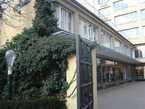New Comedy Theatre
Rudolf Wels
Václavské nám. 28, | |
| show on the map | http://www.palacustyblu.cz/index.php?f=258 |
Important events
The house was built in 1928- 1929 by architects Ludvík Kysela and Jan Jarolím in the Constructivist style and thus two low original houses were replaced by a multi-purpose structure with an arcade, famous dancing cafe Boulevard (later named Alfa), restaurant, offices, flats and a legendary cinema.
A low building was built behind the arcade toward the Franciscan orchards in 1930 by architect Rudolf Wels, where was only a storage facility, which was converted into a theatre in 1934 according to the design by Ing. Guido Lagus and where the New Theatre started to operate in the same year.
People
Architect Rudolf Wels was one of the most remarkable personality of the interwar architecture in Czechoslovakia. He studied at the Viennese Academy by Friedrich Ohman. He attended there courses by Adolf Loose, whose influence on his future work in Vienna is very considerable. Rudolf Wels worked in Karlovy Vary from the 1920s. He reconstructed and built new structures for the famous glassworks factory Moser in 1921-1922. He also designed several sets of vases with art decor. These were successful on The International Exposition of Modern Industrial and Decorative Art that was taking place in Paris in 1925.
He designed Municipal House of Culture in 1923-1925 in Sokolov, where he built two school buildings as well in the next year – the German municipal school and Czech school. His most highly regarded works contain the building of the insurance company (presently health centre) on the Milada Horáková Square, spa house Bellevue and the building of Spa N. VI in Carlsbad. Rudolf Wels moved to Prague in the 1930s, where he founded an atelier with Guido Lagus. Wels was detained in Terezín in 1942 and next year sent to the concentration camp Auschwitz, where he was murdered.
Text: Michael Rund. In: Archiweb
More theatresHis first buildings was influenced by Czech Art Deco. Later he became a typice Functionalist and he realized several important buildings in the centre of Prague. His elegant constructions are thought through technically, constrcuctionally daring and characteristic by using of huge glass surfaces.
In: Adéla Anna Vavrečková: Živé příběhy. Divadelní budovy v Olomouci a v Moravské Ostravě. Brno2007. Diplomová práce. Note 90.
More theatres
History
Additional information
No information has yet been entered
Add information














